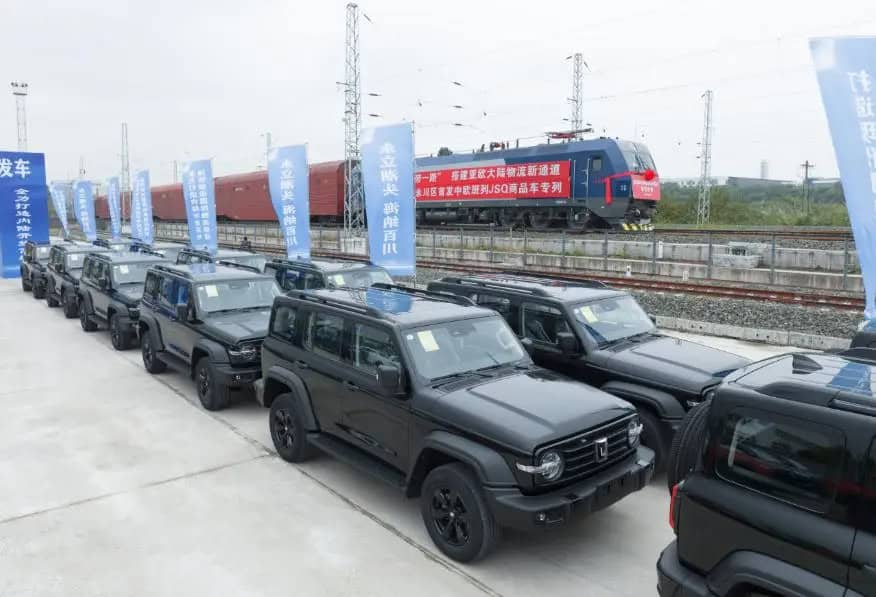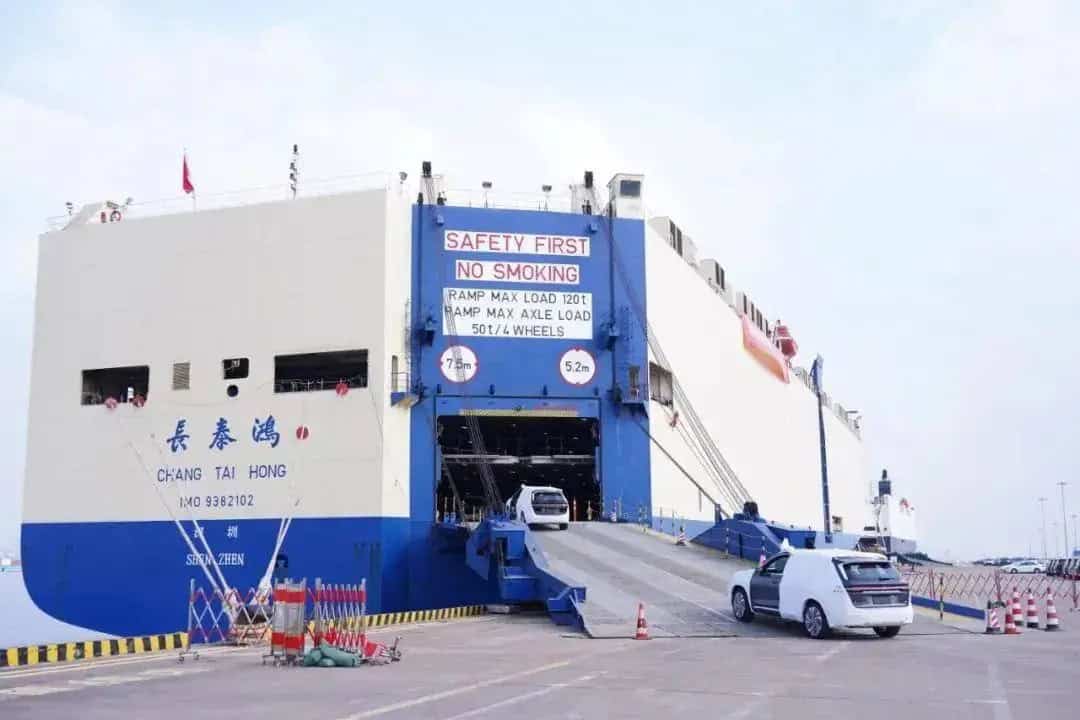Local companies are aggressively going overseas, and passenger car exports are expected to exceed the 5 million mark in 2024
January 26, 2024 Tina
For many years, the industry has generally believed that the Chinese automobile market has basically reached its peak of more than 20 million vehicles, but the world’s automobile market has reached 100 million vehicles, and electrification is undergoing a rapid transformation. As the world’s production base, why can’t China exceed 30 million, 40 million, or even 60 million vehicles? “Recently, at the “China Automobile and Parts Overseas Summit Forum” hosted by Gasgoo, Cui Dongshu, Secretary-General of the Passenger Car Association, raised a question.
What you need to know is that despite a difficult start to 2023 and everyone shouting that “survival is not easy”, China’s automobile production and sales exceeded the 30 million mark for the first time, achieving 30.161 million vehicles and 30.094 million vehicles respectively. Since reaching 29 million vehicles in 2017, this achievement has once again set a new historical record. Against this background, many experts, scholars and research institutions are optimistic that the target of 40 million vehicles seems to be no longer far away.
“At this stage, the global automobile market is undergoing drastic changes, and Chinese automobiles are expected to obtain huge growth opportunities in the changes in the world’s automobile industry.” This is Cui Dongshu’s expectation for the future development of Chinese automobiles. In his view, learning from the achievements of Huawei and Xiaomi in the global market With the successful experience of breaking through the blockades of Apple and Samsung and achieving nearly 60% market share, my country’s automobile share in the global market is expected to increase from the current 30% to 50%, or even 60%, which is not impossible to achieve.
The overseas expansion of Chinese cars will be the key to achieving this goal.
The export window is huge, and passenger cars will challenge the scale of 5 million units in 2024
Looking back at the past few years at the beginning of 2024, in addition to the booming new energy vehicle market, exports are bound to be the most eye-catching existence.
According to the latest data from the General Administration of Customs, in the past year, my country has exported 5.22 million units of automobiles, with an export growth rate of 56%. This figure has surpassed Japan, which has long been the world’s largest automobile exporter. During the same period, the average export price of automobiles was US$19,000, a slight increase from US$18,000 in 2022.

Among them, my country’s passenger car exports in 2023 were 4.433 million units, an increase of 66.1% over the same period last year. Among them, Chery Automobile, SAIC Motor (600104), BYD (002594), Geely Automobile, and Great Wall Motors (601633) have successively released their export report cards .
Specifically, Chery Group exported 937,148 vehicles this year, a year-on-year increase of 101.1%, ranking first in the export of Chinese brand passenger cars for 21 consecutive years. The soaring export volume accounts for 49.81% of the group’s total sales, a surge of 13.2 percentage points from 36.61% in 2023. With this help, Chery Group’s sales will exceed 1.88 million vehicles in 2023, a year-on-year increase of 52.6%, and its annual revenue will be higher. It is the first time that it has exceeded 300 billion yuan, a year-on-year increase of more than 50%, achieving a “big leap” of 100 billion yuan in one year.
BYD ushered in an export explosion this year. According to the latest data, as the world’s top seller of new energy vehicles, BYD will export a total of 243,000 new cars in 2023, a year-on-year increase of 334.2%. Its new energy footprint has covered six continents around the world. More than 70 countries and regions, more than 400 cities, and achieved good results in multiple markets.
It is precisely based on the gratifying export results in 2023 that many car companies have officially announced export targets for 2024.
“In 2024, SAIC’s overseas sales target is heading towards 1.35 million vehicles, and the plan for 2025 is to exceed the 1.5 million level.” Zhao Aimin, Secretary of the Party Committee and Deputy General Manager of SAIC International, revealed to Gasgoo.
Changan Automobile introduced at the recent Global Partner Conference that it will introduce more than 7 new energy products such as Avita 11, Lumin, and CD701 into the Southeast Asian market in 2024, and complete the construction of more than 530 channel contact points; in Europe market, more than 5 new energy products such as Avita 11, Deep Blue S7, and C327 will be introduced one after another; and it will accelerate its entry into blank markets such as Australia, New Zealand, South Africa, and Israel, and the export volume is expected to reach more than 500,000 vehicles.
In this context, Gasgoo Automobile Research Institute predicts that “my country’s passenger car exports are expected to be around 5 million units in 2024, of which Chery, BYD, Geely and SAIC are expected to contribute 750,000 units to the export increase.”
Transport capacity restricts development, and ship buying and shipbuilding, as well as China-Europe special trains, are fully guaranteed to go out to sea.
The development trend of automobile exports is clear, but for now, since the domestic automobile export volume has soared, the shipping capacity of roller ships has been seriously insufficient, which is becoming a sweet burden in the development of my country’s automobile industry.
Clarkson, a shipping research organization, once pointed out in a report: As of November 2023, there are approximately 760 ro-ro ships in the world, an increase of only 2% from 2019, and the annual transport capacity is approximately 4 million vehicles, but only Chinese passenger cars are exported in a year. The volume has exceeded 4.43 million vehicles. Against this background, from August 2020 to the end of November 2023, the one-year rent of a 6,500-standard car carrier has soared from US$10,000/day to US$115,000/day, an increase of more than 10 times.
Therefore, in order to seize this trend, SAIC, BYD and Chery Group have set up their own fleets to build ships and “go to sea”. “Shipbuilding has a long cycle and cannot keep up with the speed of automobile exports at this stage. When China’s exports reach a certain scale, the security and stability of the supply chain will be very important.” said Jin Qi, general manager of SAIC Anji Logistics.
Take SAIC as an example. Just one day before the article was published, that is, on January 24, the clean energy (LNG dual fuel) ro-ro ship “SAIC Anji Shencheng” with the world’s largest active loading capacity (7,600 parking spaces) and the most domestically produced “, loaded with self-owned brand new cars from SAIC, Dongfeng and Yutong, set sail from Xiamen Port and headed to Europe. This is also the largest batch of automobile exports from Xiamen Port in a single voyage.
Jin Qi further revealed, “In order to ensure overseas transportation, SAIC started investing in shipbuilding two years ago. By the end of 2026, there will be 44 ro-ro ships, which can meet the domestic transportation capacity of 1.2 million and the overseas transoceanic transportation capacity of 600,000. The total transportation capacity is 1.8 million. ”
On January 9, the BYD car ro-ro transport ship “BYD EXPLORER NO.1”, which can carry 7,000 cars, was officially delivered and departed from Yantai, Shandong Province. According to previous news, this is only 8 large car transport ships. The first order and subsequent transport ships will be launched one after another around 2025.
As the number one exporter of Chinese brand passenger cars, Chery Group announced the establishment of its own fleet in early 2023, and jointly built a car transport ship construction base in Weihai with its Wuhu Shipyard. The first batch of three 7,000-space LNG dual-fuel powered vehicles The transport ship is expected to be completed within this year to meet Chery Automobile’s need to accelerate exports to South America and Europe.
If we trace the time further back to 2019, GAC Trading, a subsidiary of GAC Group (601238), has jointly invested with China Merchants Shipping to establish Guangzhou China Merchants Ro-Ro Transportation Company, etc. According to the investment promotion and ro-ro plan, by 2026, its industrial platform will add 5 new ocean-going ships. By 2030, it will build a ro-ro shipping fleet consisting of 10 Yangtze River vessels, 12 coastal vessels, and 16-18 foreign trade ro-ro vessels. force fleet.
Clarkson revealed that global shipyards will receive a total of 80 new orders for ro-ro ships in 2023, with a total capacity of approximately 67,000 standard parking spaces, of which 90% of the new orders will come from China. However, it is obvious that compared with the increasing total export volume, the speed of shipbuilding may not be able to keep up. Therefore, since 2023, more and more car companies have turned their attention from sea freight to China-Europe special trains.
Taking Tianjin as an example, “New energy vehicles produced in the Beijing-Tianjin-Hebei region have the shortest distance to the sea from Tianjin. It used to take 45 days to travel by sea. Now it takes more than two weeks to reach Central Asia and Europe through the China-Europe Express.” In addition to the low price, safety and reliability of railway transportation, more and more cargo owners prefer China-Europe freight trains,” said the relevant person in charge of Tianjin Sea-Railway Group Co., Ltd.
Up to now, my country’s important automobile industry cities such as Tianjin, Xi’an, Chongqing, Guangzhou, Suzhou, Wuhan, and Hefei have opened China-Europe freight trains. As of November 27, the 2023 China-Europe freight trains (Chang’an) will only have complete vehicle trains. 211 trains have been run. If each train carries 110 vehicles, the total number of vehicles on a single line alone exceeds 23,000.
There are many constraints on exports. The key is to fight a good positional war and a protracted war.
“Heaven helps, high quality, people work hard, and geographical changes”, Cui Dongshu summarized the growth of China’s automobile exports in the past three years with these four points.
His analysis pointed out that the surge in China’s automobile exports not only resulted from overseas inflation, supply chain difficulties, geopolitics, the emergence and transformation of the manufacturing industry and other window opportunities, but also from the improvement of competitiveness brought about by the improvement of the quality of independent brand fuel vehicles and leading intelligence. , superimposed on leading the international trend of electric vehicles, allowing independent brands to usher in unprecedented development opportunities.
However, the challenges faced by such development opportunities are by no means as simple as the transportation capacity mentioned above. For example, the management department has a stricter regulatory attitude towards the transportation of new energy vehicles. Another example is the efforts of local governments to exclude Chinese-made vehicles from the subsidy list. Furthermore, the US “Inflation Reduction Act” even requires key materials in electric vehicle power batteries. Decoupling from China and so on.
Taking Europe as an example, after the 2023 IAA Auto Show, the EU quickly launched an anti-subsidy investigation against three Chinese car companies, BYD, Geely, and SAIC, which sounded the alarm for Chinese car companies. As for the new battery bill passed by the European Union, it has begun to count the carbon footprint and carbon emissions of batteries made in China. In the future, the threshold for Chinese battery companies to enter Europe will only become higher and higher.
At the same time, with the reduction of new energy subsidies, the growth rate of new energy vehicles in Europe may gradually slow down. At the same time, potential tariff increases on Chinese pure electric vehicles will begin as soon as July, which will directly affect China’s new energy vehicles. (600617) The pace of automobile competition in Europe.
However, the above operations are not absolutely bad in the view of Fu Yuwu, honorary chairman of the China Society of Automotive Engineers and China Automotive Talent Research Association. “This just shows that our recent path is on the right track. China’s actions and efficiency in the field of electric vehicles , speed and rhythm have aroused the international automotive community’s vigilance towards us.”
He believes that tariff barriers, tariff barriers, carbon barriers, and technical barriers will all likely follow one after another. Chinese automobile companies must improve their products, have a deep understanding of the market, culture, regulations, standards and consumer habits of developed countries such as Europe, make preparations in all aspects, and fight a positional and protracted war. Among them, positional warfare means building factories locally to avoid or circumvent various barriers; protracted warfare requires Chinese automobile companies to delve deeply into the international market and continuously improve product reputation and market competitiveness.
“The next step for automobiles to go overseas will be to go overseas for industries. There is huge room for improvement from localized channel construction to localized production.” Cui Dongshu further pointed out that if the overseas localization strategy had not been adopted, 5 million vehicles would have been the number of Chinese cars. A significant spike in export volumes.
It is based on this understanding that while buying a ship to go overseas, BYD Auto officially announced in early July 2023 that it would invest in building its first overseas passenger car production base and a large production base consisting of three factories in Thailand and Brazil respectively. After the complex, it was announced again on December 22 of the same year that it would build a new energy vehicle production base in Szeged, Hungary, becoming the first large-scale automobile factory established by a new Chinese brand in Europe.
At that time, BYD Europe CEO Michael Shu said that “if possible”, it hopes to become the largest seller of electric vehicles in Europe and account for one-tenth of the region’s pure electric vehicle sales by the end of 2030.
Not only BYD, SAIC Group currently has four overseas bases in India, Indonesia, Thailand, and Pakistan, and is actively promoting the location selection of European production bases. Barring no accidents, it may be completed and put into production from 2025 to 2026, and radiate. the entire European market. Also to be put into use in 2025 is the Changan Automobile (000625) manufacturing base in Rayong, Thailand. With the expansion of production capacity in the future, it will reach an annual production capacity of 200,000 vehicles.
As we have just entered 2024, Victor Zhang, head of Chery Automobile’s UK region, can’t wait to say that the Omenda brand will be introduced to the British market this spring, and then the Jaecoo brand high-end models will be launched in the summer, and plans to achieve localization by 2030. Production. At the same time, Chery Automobile will also be committed to promoting the location selection of European production bases.
Cui Dongshu concluded that “overseas localization will be a huge development opportunity, especially for China in Southeast Asia, Europe, Mexico and other places.”
“The next ten and twenty years are two important nodes. If we fight a good positional war in the first ten years and persist in fighting a protracted war for twenty years, I believe that world-class automobile brands and companies will surely rise in China. “Fu Yuwu said like this.




